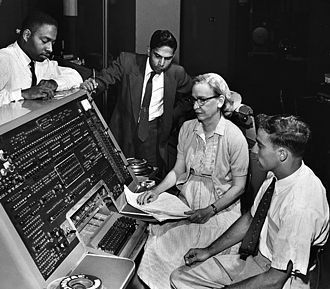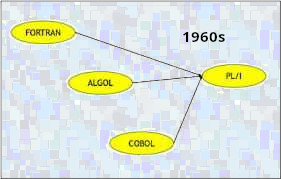| Computer Languages by Committee - the 1960s |
| Written by Historian | ||||||||
Page 4 of 4
The Two CulturesThe formation of the two committees that led to the creation of Algol and COBOL was the first and clearest sign of the split in the industry between the academic and commercial. This split is alive and well today and can be found everywhere. The only real change is the introduction of a third grouping in the 70's - the enthusiasts - who manage to irritate both of the older groupings! COBOL went on to become for a time the most widely used language, even overtaking Fortran's head start.
Grace Hopper And Team Getting Cobol Working On A Univac 1 And what of Algol? Well without trying to be kind, all that can be said is that it died a death. Even so the academics have had a partial last laugh in that Algol gave rise to most of the modern languages that we consider so good - Pascal, Modula, C, Java, C#, Python and Ruby all owe their fundamental structure to Algol.Of course COBOL is still in use, and so is Fortran, but in time the ghost, or should it be ghoul, of Algol may still rule the world. Diversity of languages?Because Cobol caught on and satisfied the needs of the business community there were very few challenges to its supremacy. Apart from RPG (Report Program Generator) from IBM, alternative business languages were basically jazzed up COBOL. In the scientific area users were basically happy with Fortran and its offshoots were once again specialisations, such as GPSS for simulation. Where the real diversity of languages is to be found is in the academic camp. Algol never really caught on and so new candidates were produced every few days. Algol 60 became Algol 68, Algol W, Simula and eventually C, Pascal, Ada and others. In many ways Algol was ahead of its time and most of its descendants enjoyed a well-deserved impact later on. Other non-Algol based languages that were important in a minor sort of way were:
You can see from this list that most of the minor players of the 60's were niche languages that had their particular application area and their particular avid supporters, who often claimed that they were the general purpose language of the future. The candidate that at the time was taken seriously as a language that seemed to have a long future ahead of it was PL/1 (1965). Given that the three major applications areas could be covered by Fortran, Algol and Cobol why not create a super language that incorporated features from all three - thus PL/1 was devised. This was another IBM-backed language, like Fortran, only unlike Fortran this super language failed to gain users. The reasons were that it was too big, too slow and well before its time. PL/1 was a dinosaur and micro computers and BASIC were just around the corner.... For the development of other computer languages see the other parts of this series covering the 1950s to the 1980s.
Related ArticlesOn this day in 1959 - COBOL Committee formed Grace Hopper - The Mother of Cobol Grace Hopper and the Invention of the Information Age (book review) Software Pioneers: Contributions to Software Engineering (book review) John Backus - the Father of Fortran Assemblers and assembly language
To be informed about new articles on I Programmer, sign up for our weekly newsletter, subscribe to the RSS feed and follow us on Twitter, Facebook or Linkedin.
Comments
or email your comment to: comments@i-programmer.info <ASIN:026201310X> <ASIN:0070411557>
|
||||||||
| Last Updated ( Thursday, 30 January 2025 ) |



